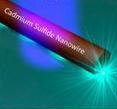Scientists Create World's Smallest Laser
by
Brendon Nafziger, DOTmed News Associate Editor | September 09, 2009

5 nanometers wide,
the plasmon laser is only
twice as big as a single
strand of DNA
Scientists at the University of California, Berkeley have created the world's smallest laser, according to a paper published in the advance online edition of Nature on Aug. 30.
Pressed into a vanishingly small 5-nanometer-wide gap, the tiny beamlet, called a hybrid plasmon laser, is about twice as big as a single string of DNA.
Previously, many physicists thought light could not be made smaller than half its own wavelength.
"This limit was something researchers were trying very hard for the last couple of years to [break]," Volker Sorger, a Ph.D. student at UC Berkeley's Nanoscale and Engineering Sciences lab, and a lead author on the study, tells DOTmed News.
What scientists found was that light could be reduced beyond its conventional limits by binding it to electron fields on the surface of metals.
Imagine the electrons on a metal's surface as "a row of ducks sitting on water," explains Sorger. The scientists then shine a light onto the metal, and the light acts like a stone thrown into the water. "It creates waves," says Sorger. "A wave comes along, and the ducks go up and down. This is what the electrons do" in response to light, says Sorger. "They basically create an oscillating field," known as surface plasmons, he says, which can be crushed into nano-sized spaces.
The tricky part was then keeping the plasmons focused and coherent -- something the UC Berkeley team was able to do by squeezing them into a tiny gap made by having a nanowire almost touch a silver surface. "You don't bring it in absolute close contact," says Sorger. "You leave a little bit of gap. This sucks in the light."
The 50-nanometer-long nanowire, made of cadmium sulfide, a semiconductor, then amplifies this light field, thereby creating the coherent light -- or laser -- in the gap.
Sorger believes this laser will have widespread applications. "You could detect a single molecule, a single nanometer in dimension," Sorger says, which could be used in airport security, for instance, to detect a solitary molecule of TNT coming off someone's luggage. "That is something that people have never been able to do before," says Sorger, "because light was always so much bigger than the true nanoscale."
Other possible uses include extremely fine-tuned biological experiments, as well as high-speed chips that, according to simulations developed by Sorger's team, would run 100,000 times faster than current technology.
"People were saying the 20th century was the century of the electron," Sorger says. Now it's the "era of photons, of light."
